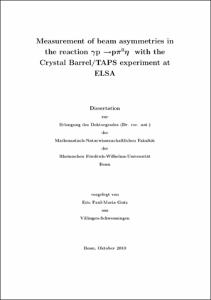Measurement of beam asymmetries in the reaction γp→pπ0η with the Crystal Barrel/TAPS experiment at ELSA

Measurement of beam asymmetries in the reaction γp→pπ0η with the Crystal Barrel/TAPS experiment at ELSA

| dc.contributor.advisor | Thoma, Ulrike | |
| dc.contributor.author | Gutz, Eric Paul-Maria | |
| dc.date.accessioned | 2020-04-16T18:00:55Z | |
| dc.date.available | 2020-04-16T18:00:55Z | |
| dc.date.issued | 06.01.2011 | |
| dc.identifier.uri | https://hdl.handle.net/20.500.11811/4905 | |
| dc.description.abstract | The photoproduction of mesons off the nucleon provides an excellent tool to gain further insight into the structure of baryons and their excitation spectrum. A large number of final states yielding various resonance contributions are accessible in photoproduction experiments. Especially in the regime of high-lying resonances, the photoproduction of multi-meson final states is of increasing importance, giving access to sequential decays of such resonances via e.g. Δ(1232)P33 or N(1535)S11 in the intermediate state. For a complete understanding of the processes involved, however, it is insufficient to measure only unpolarized total and differential cross sections. The extraction of polarization observables from data obtained using polarized beams and targets is mandatory to constrain theoretical models and analyses and to uniquely determine the amplitudes participating in a given process. This work presents the analysis of data taken with the Crystal-Barrel/TAPS experiment at the accelerator facility ELSA in Bonn, using a linearly polarized photon beam impinging on a liquid hydrogen target. The detector system is optimized for the detection of multi-photon final states. The data has been selected for the reaction γp→pπ0η→p4γ for an incoming photon energy range of 970 MeV to 1650 MeV. In this range, photon polarizations of up to 50% have been achieved. From this data, all polarization observables accessible with a linearly polarized photon beam and an unpolarized target have been extracted. This includes the beam asymmetry Σ, determined as a function of various invariant masses and angles using a quasi two-body approach, along with the three-body asymmetries Ic and Is. The latter two observables are unique to the acoplanar kinematics of multi-meson final states and have been measured for the first time within this work. The comparison of the results to solutions derived from various theoretical frameworks demonstrates the sensitivity of the observables to the contributing resonances and their decays. | en |
| dc.description.abstract | Messung von Strahlasymmetrien in der Reaktion γp→pπ0η mit dem Crystal Barrel/TAPS Experiment an ELSA Die Photoproduktion von Mesonen am Nukleon ist hervorragend dazu geeignet, ein besseres Verständnis der Struktur der Baryonen und ihres Anregungsspektrums zu gewinnen. In Photoproduktionsexperimenten ist eine Vielzahl von Endzuständen zugänglich, zu denen verschiedene Resonanzen auf unterschiedliche Weise beitragen. Insbesondere im Bereich höherliegender Anregungsenergien gewinnt hierbei die Multi-Meson-Produktion an Bedeutung und erlaubt den Zugang zu sequentiellen Resonanzzerfällen, z.B. über Zustände wie Δ(1232)P33 oder N(1535)S11. Für ein umfassendes Verständnis der beteiligten Prozesse ist allerdings die reine Messung von totalen und differenziellen Wirkungsquerschnitten unzureichend. Für die eindeutige Bestimmung der an einem Prozess beteiligten Amplituden ist zudem die Extraktion von Polarisationsobservablen unabdingbar. Hierzu sind Experimente unter Verwendung polarisierter Photonstrahlen und polarisierter Targets notwendig. In der vorliegenden Arbeit wird die Analyse von Daten präsentiert, die mit dem Crystal-Barrel/TAPS-Experiment an der Bonner Beschleunigeranlage ELSA gewonnen wurden. Hierbei kam ein linear polarisierter Photonenstrahl, der auf ein Flüssigwasserstoff-Target traf, zum Einsatz. Das Detektorsystem ist auf den Nachweis von Viel-Photonen-Endzuständen optimiert. Die Daten wurden für einen Energiebereich der einlaufenden Photonen von 970 MeV bis 1650 MeV im Hinblick auf die Reaktion γp→pπ0η→p4γ selektiert. In diesem Bereich konnten Polarisationsgrade von bis zu 50% erreicht werden. Aus diesen Daten wurden sämtliche Polarisationsobservablen extrahiert, die mittels linear polarisierter Photonen und einem unpolarisierten Target zugänglich sind. Dies beinhaltet die Quasi-Zweikörper-Strahlasymmetrie Σ, die als Funktion verschiedener invarianter Massen und Winkel bestimmt wurde. Zudem wurden zum ersten Mal die Dreikörper-Asymmetrien Ic und Is gemessen, die einzig in der akoplanaren Kinematik von Multi-Mesonen-Endzuständen auftreten. Der Vergleich der gewonnenen Daten mit Ergebnissen verschiedener theoretischer Ansätze zeigt die Sensitivität der Observablen auf die beitragenden Resonanzen und ihre Zerfälle. | en |
| dc.language.iso | eng | |
| dc.rights | In Copyright | |
| dc.rights.uri | http://rightsstatements.org/vocab/InC/1.0/ | |
| dc.subject | Photoproduktion | |
| dc.subject | Polarisationsobservablen | |
| dc.subject | Baryonzerfälle | |
| dc.subject | Mesonproduktion | |
| dc.subject | pseudoskalare Mesonen | |
| dc.subject | photoproduction | |
| dc.subject | polarisation observables | |
| dc.subject | decays of baryons | |
| dc.subject | meson production | |
| dc.subject | pseudoscalar mesons | |
| dc.subject.ddc | 530 Physik | |
| dc.title | Measurement of beam asymmetries in the reaction γp→pπ0η with the Crystal Barrel/TAPS experiment at ELSA | |
| dc.type | Dissertation oder Habilitation | |
| dc.publisher.name | Universitäts- und Landesbibliothek Bonn | |
| dc.publisher.location | Bonn | |
| dc.rights.accessRights | openAccess | |
| dc.identifier.urn | https://nbn-resolving.org/urn:nbn:de:hbz:5N-23933 | |
| ulbbn.pubtype | Erstveröffentlichung | |
| ulbbnediss.affiliation.name | Rheinische Friedrich-Wilhelms-Universität Bonn | |
| ulbbnediss.affiliation.location | Bonn | |
| ulbbnediss.thesis.level | Dissertation | |
| ulbbnediss.dissID | 2393 | |
| ulbbnediss.date.accepted | 20.12.2010 | |
| ulbbnediss.fakultaet | Mathematisch-Naturwissenschaftliche Fakultät | |
| dc.contributor.coReferee | Weinheimer, Christian |
Files in this item
This item appears in the following Collection(s)
-
E-Dissertationen (4444)




